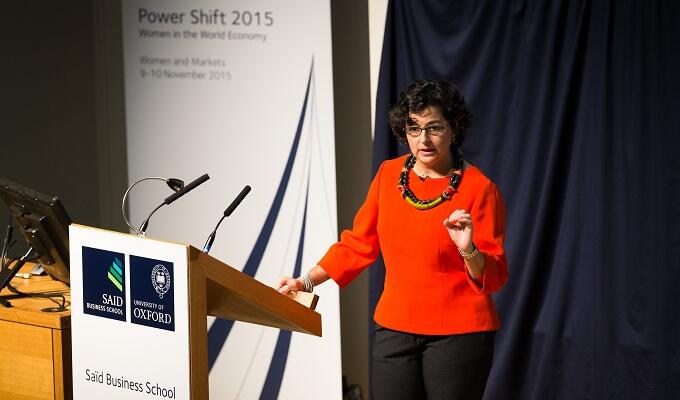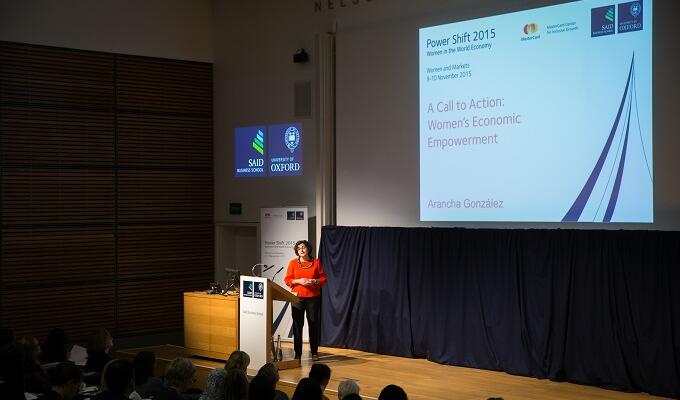

Power shift 2015: women and markets “opening markets for equality”
Statement by Arancha Gonzalez Executive Director International Trade Centre
at the Oxford Forum for Women in the World Economy
9 November 2015
Good morning Ladies and Gentlemen,
I would like to start off by thanking Linda Scott and the Saïd Business School for yet again putting together this excellent gathering of men and women ‘power shifters’ to discuss and be inspired by ways that we can support women’s integration into markets.
Last month at the United Nations, when the new set of global development goals was being adopted, Linda delivered a statement on “the economics of exclusion” which underscored that “women are the largest excluded group in the planet” and that better support to women was required. At the International Trade Centre (ITC), we couldn’t agree more.
ITC has been providing trade-related support to developing countries for over 50 years now. Making trade possible did not necessarily make trade happen and this is why ITC was created to bridge this gap. One of the biggest inequalities that we see is in the realm of women and markets.
Women comprise half of humanity. Yet recognition of their contribution to the economy pales in comparison.
Although we know that the women-owned SMEs who export are paying better wages; being more productive; employing more workers; and reporting higher average sales than women-owned firms that do not export, ITC survey data across 20 countries reveals that only one in five exporting companies is owned by women.
Women-owned companies also tend to be on the smaller side and engaged in lower levels of value addition and are therefore usually underrepresented in sectors that are more likely to export.
Out of 173 economies measured by a recent World Bank study, as many as 90% have at least one law impeding women’s economic opportunities. Today, there are still at least 18 economies where husbands can legally prevent their wives from working.
And, globally speaking, women-owned SMEs account for a little above 30% of SMEs. At the national level, the numbers are even lower, especially in many developing countries. In Egypt, Botswana, Morocco and Tunisia the percentage of women-owned businesses range between 3% and 6%. This is what official statistics tell us. But let’s not forget that many women entrepreneurs are in the “invisible” informal sector.
These inequalities, as all of you know, extend well beyond the realm of law. Behind these inequalities often lie informal and formal barriers related to access to finance; to real-time information about market dynamics and business and networking opportunities; to relevant skills training; to social and cultural barriers.
If these barriers are addressed, opening up markets and trade can be a powerful “leveller of the playing field” for women. The question is how? How can we rise to the challenge of inclusion?
There are increasing global efforts to address this key issue. The UN Global Goals make a strong case for women’s empowerment. G20 Leaders have expressly embraced women as a global growth generator. And in Japan and several other countries the idea of “womenomics” is becoming a key component of national growth agendas.
With our 100% hands-on focus, ITC is decisively stepping up its game to contribute to women’s economic empowerment. Just two months ago we launched a five-year Call to Action for governments, institutions, businesses, and individuals to bring one million women entrepreneurs from the developing world to market by 2020.
Since the launch on 1 September 2015, governments and companies have pledged commitments to engage in one or more of the Call to Action’s eight pillars, spanning offer and demand.
All stakeholders have concrete roles to play across the eight areas of the Call to Action: whether it be data collection, analysis and dissemination; trade policy; corporate procurement; public procurement; certification; addressing supply side constraints; financial services; and ownership rights.
Let’s look at data, the first pillar of the Call to Action. Governments and public agencies need to collect sex-disaggregated data about women’s participation in the economy. And here I hope that the indicators being developed to measure progress in the Global Gaols will go beyond measuring the number of women in Parliaments!
We should look at more relevant indicators of progress such as number of women entrepreneurs registered or the number of women entrepreneurs accessing credit. But beyond looking at outputs and outcomes we also need to look at the impact of women’s inclusion in in the economy on societies.
Businesses also have an amazing ability to contribute to the economic empowerment of women by “doing good while they do business”. By committing to procure from women vendors and by tracking it! And the same goes when it is the State that buys, when it is about government procurement. Because procuring is not neutral. Buying is not neutral. Markets are very powerful but they are not neutral. In the hands of the purchaser lies a huge ability to change our economies. This is why in December we will be launching an app winner of our tech-challenge to help connect women entrepreneurs to markets.
Let’s take another example, financial services: we will struggle to achieve equal access to finance unless financial institutions, governments, and regulators each do their part. SMEs consistently cite lack of access to finance as a severe constraint. Despite options like permitting the use of collateral substitutes and creating appropriate exceptions to capital requirements, often, the costs and risks of serving SMEs are perceived to be too high by banks. Because of information asymmetries and the high costs of gathering adequate information to assess the creditworthiness of typical SME borrowers, banks are usually reluctant to extend them unsecured credit, even at high interest rates.
As a result, many SMEs with economically viable projects, but inadequate collateral, cannot obtain the much needed financing from traditional lenders. Female entrepreneurs are particularly exposed to this problem as lack of collateral, inadequate financial infrastructure and other barriers involving gender-based social and cultural norms restrict the potential of women-owned SMEs.
All of this is what we know. What matters now is acting and acting fast. Because gender equality is last century’s pending task. We can no longer go incremental. We need to change speed and scale.
ITC is ready to put its money where its mouth is. We have committed to ensure that women benefit from 40% of our activities, from facilitating access to market intelligence all the way to connecting them to new buyers in traditional and non-traditional sectors. And this includes the computer, telecommunications, and consumer electronics’ sector where there is a higher than average rate of female ownership; which shows that women are also big innovators.
We have also committed to gender parity across all levels of ITC by 2020.
As I conclude, let me say once again that the world economy will remain below potential as long as women do not have the rights, the skills, and the market opportunities they need to make the most of their talents. I want to invite each and every one in this room, whether man or woman, to join in our Call to Action. Please make your contribution let Power Shift 2015 and Oxford be remembered as a key step in support of women in the economy.
Thank you.



